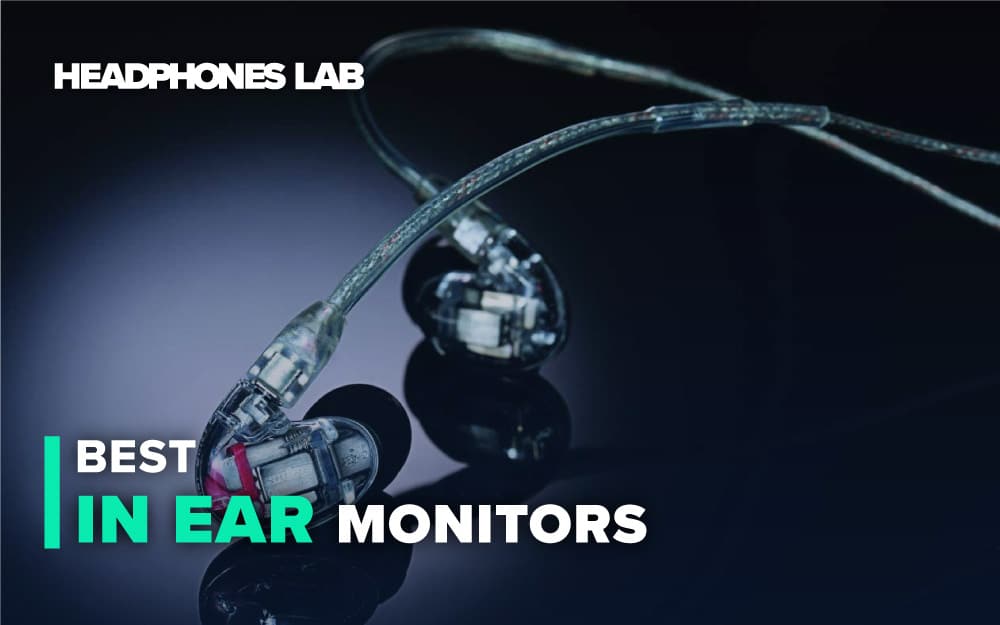The market is dominated by headphones that offer a powerful base at the expense of accurate audio reproduction. And while that may be beneficial for your average person, it’s absolutely not ideal for someone who needs to monitor audio.
If you need to perform live or maybe mix a track, then in-ear monitors are quite possibly your best – especially for performing live.
The only problem is that there are so many options out there that finding the best ones is a chore, and, quite frankly, a bit of a challenge. That’s why we decided to share our top 5 picks with you!
So, without any further ado, let us get right into it!
Things to Look out for
Before buying in-ear monitors or any other type of earbuds/headphones, there are things to look out for that are going to make the decision process much easier. Here are some of the most important ones for in-ear monitors:
- Audio reproduction: Monitors need to be, well, monitors. You need to look out for something that reproduces as the sound as clearly as possible without brighter, more bassy, or anything in between. If you can try out some monitors yourself, that would be for the best. Otherwise, there is no option but to rely on reviews such as this one
- Build quality: You don’t want your monitors giving up on you during a performance. You can usually tell how durable earphones can be with a touch (Up to a certain point), but, the best way is to arguably rely on the opinions of hundreds of reviewers who have been using them for a long time
- Comfiness: Some in-ear monitors can be pretty uncomfortable. That can be a huge deal-breaker if you plan on using your monitors for extended periods of time. So, keep an out for it
- Noise isolation: Most in-ear monitors are pretty good at blocking outside noises since they rest inside your ear canal. But, still, it’s something to look out for
- Microphone and connector: If you plan on using your monitors as normal earbuds as well, you may need a pair with an in-line microphone and a 3.5mm connector as well
- Detachable/Removable Cables: Being able to remove the cable and re-attach it later can be a lifesaver. Not only it makes carrying the monitors much easier – but it also gives you the option of replacing damaged cables or using something of higher quality if you wish to do so
Our 5 Best In-Ear Monitors
These are some of the most important things that you’ll want to keep in mind. Some may argue that impedance is important as well – but most of the popular in-ear monitors we’ve seen come in at less than 30 ohms, so, it’s usually nothing to worry about for such monitors.
So, with all that out of the way, here are our top 5 picks!
1: Easy KZ ZST
Best Budget In-Ear Monitors
It’s no secret that in-ear monitors can get insanely expensive. But, if your budget is insanely low, then the Easy KZ ZSTs are quite possibly your best pick. At about $20, it’s hard to go wrong with them!
Audio signature: Slightly boomy and sharp
Removable cables: Yes (Proprietary to 3.5mm)
These are obviously not the best monitors that you can get. Far from it. In fact, there are several consumer-oriented open-back headphones at a low price-point that can surpass these in terms of neutral sound. However, none can get close to it without asking for at least 3 times more.
To be more specific, while the bass is generally accurate, it can also get a bit overemphasized and that can make the monitors a bit boomy and maybe even “muddy” in certain occasions. As per usual with such earbuds, the high frequencies are also overemphasized to compensate for the boomy bass. In the end, you get monitors that while they are as neutral as you can get for 20 bucks, they can also become very fatiguing over long periods of usage.
That’s more or less when the downsides end. Cause other than that, you get removable cables, decent build quality (Especially for $20), and decent noise isolation as well.
One thing we didn’t really like about the cables is that they use a proprietary connector. This means that if you end up breaking them somehow, finding a replacement can prove to be much more challenging than grabbing the next 3.5mm cable you come across. Not to mention anything about the pins and how easy it can be to damage them if you’re not careful.
Unfortunately, this seems to be a recurring theme with other monitors and headphones as well – even from premium brands such as Sennheiser.
Pros:
- Extremely cheap
- Removable cables
- Multiple sizes of ear tips included in the box
- There’s a version with a mic if you need it
- Decent sound for the money
- Decent build quality
Cons:
- Their sound can get a bit fatiguing over long periods of usage (Even though we can’t complain at this price point)
- Noise isolation is mediocre for live performances
2: Sennheiser IE800S
Best High-End Option
Sennheiser is quite possibly the biggest name in the audiophile industry. They are one of the very few brands that can sell headphones and earbuds for several thousands of dollars – and for a good reason. If you need neutral sound, their high-end equipment is almost unmatched.
If you ever bothered with audiophile headphones, there’s a good chance that you’ve heard of the Sennheiser HD 800 S. These are high-end, audiophile headphones that flirt with a close to $2K price-tag. The IE800S are also up there – except they are in-ear monitors instead of open-back headphones and they are also a bit cheaper at about one grand!
Audio signature: Neutral
Removable cables: No
Most high-end over-ear headphones come with impedances of about 300 ohms. This means that you can’t really use them effectively and to their full potential without a proper amp. Thankfully, this doesn’t apply to most in-ears and it certainly doesn’t for the IE800S as their impedance is only at 16 ohms!
This means that you can enjoy neutral sound on pretty much anything from smartphones to expensive DACs.
Speaking of sound, while we’d be hard-pressed to compare it against the HD 800 S (Mostly due to the fact that soundstage makes a big difference), it’s still very impressive for in-ear monitors/earbuds.
Obviously, in this case, “impressive” doesn’t mean “Dynamic, punchy, bassy” or anything like that. These are not exactly targeted towards your average person who likes that kind of colored sound. Instead, as per usual with Sennheiser, their sound is a bit more neutral and accurate – which is the kind of sound that you’d want from in-ear monitors.
Pros:
- Neutral sound
- Good soundstage (As far as earbuds are concerned)
- Solid build
Cons:
- Non-removable cable
- Expensive
3: Shure PSM300
Best (Affordable) Wireless Option
When it comes to performing live, you’ll obviously need something that’s wireless. Finding the ideal combination with transmitters, receivers, and monitors can be a huge pain.
The Shure PSM300, however, offers the whole package for much less than one grand. That’s one of the main reasons that we love it so much and why we think it’s worth a spot on our top 5.
Audio signature: A bit bright but close to neutral
Removable cables: Yes (Even though you’ll be using them wirelessly anyway)
Truth be told, their sound can hardly be compared to Sennheiser’s premium offering. And we’re not saying that these have bad sound – not by a long shot. It’s just that when compared to the IE800S, something feels off. Particularly in the high frequencies.
Then again, Sennheiser only offers the monitors while Shure gives you the whole package for $200 less. So, it only makes sense. In fact, the included monitors are the SE215s that you can generally grab for about $80. There’s almost no comparison between them and monitors that cost ten times as much.
Now, at about $700, this package definitely not cheap – but it offers superb value. Especially when compared to its almost $5000 flagship variant. That’s why we include (Affordable) in brackets. Cause if you truly want the best that money can buy, you’re going to have to spend much more than that.
But, as far as value is concerned, these are great. Decent sound, decent build, and a full-wireless package for less than one grant – we can’t ask for much more.
The only downside is that the monitors can get a bit too sharp. But, again, we can hardly complain at this price point.
Pros:
- Noise isolation is extremely impressive (Especially if you consider the fact that there is no ANC)
- Great value
- Easy to use
Cons:
- The monitors can be a little bit bright
4: KZ AS10
Best Value
For about $60, you obviously can’t expect to get the best audio reproduction that’s out there. But, still, for the money that these IEMs are asking, they offer an insane value that’s tough to beat.
Audio signature: A bit boomy but balanced
Removable cables: Yes (Proprietary to 3.5mm)
Just like with our budget KZ pick, the KZ AS10 also comes with a removable cable. This means that even if it gets damaged you can replace it without having to throw the IEMs away or bringing them to a local repair shop.
While the mids and highs are fairly balanced and sound pretty much like IEMs, the base is a bit too boomy. And we’re not saying that they are ideal for bass lovers – we’re saying that there is a bit more base than there should be for accurate audio reproduction. That’s it. These are still close to neutral-sounding monitors and are not to be confused with your average pair of mid-range earbuds.
One thing that’s truly a surprise here is the noise isolation properties of these monitors. They can easily match or surpass even some of the most expensive IEMs out there without even using ANC. So, we’d say that if noise isolation is at the top of your priority list, definitely pay attention to these regardless of your budget.
Build quality is also pretty good. The monitors feel very sturdy and durable. The only downside is that the cables are rather thin and despite being braided, we wouldn’t say they feel particularly durable. Then again, as we mentioned above, they are removable and replaceable, so, that shouldn’t be a big issue.
Pros:
- Removable cables
- Great value
- Decent build
- Superb noise isolation
Cons:
- The sound can get a bit boomy
5: Shure SE846
Best-Sounding In-Ears
Sound is often quite subjective. Some people like base while others prefer brighter headphones with audiophiles usually sitting somewhere in the middle. Despite that, we can almost safely say that nobody is going to end up disappointed with the Shure SE846s.
Audio signature: Adjustable (Warm, balanced, bright)
Removable cables: Yes (Proprietary to 3.5mm)
One of the first things that surprised us is the soundstage. Normally, in-ears are the worst choice in terms of soundstage. After all, you need the headphones to communicate with the outer layers of your ears and you also need the open-back design for that “airy” feeling.
Still, the SE846 somehow manages to deliver a somewhat wide soundstage. This could be thanks to the fact that there are four drivers in there. Despite that, the impedance is only 9 ohms – which means you can easily drive them with everything.
Speaking of sound, the monitors are highly adjustable both in terms of hardware and software. So, if you want a bit more punchy base or maybe something a bit sharper, that can be done with both the use of the removable nozzle inserts and equalizers as well.
Sound isolation is pretty good – but it still somehow struggles to compete with the much cheaper KZ AS10s. We’d say that most of you are likely to be satisfied, though.
The cables do feel a bit weird and maybe even unusual. At the same time, we’d say they also feel pretty durable.
As you’d probably expect at this price point, the earbuds come with multiple pairs of ear-tips at different sizes so that you’ll be able to find the perfect fit for your ears.
Pros:
- Multiple options for adjusting the sound signature
- Great sound in general
- Sturdy
- Comfortable
- Great noise isolation
Cons:
- Expensive
Wrapping Up
These are our top picks for now. Here is everything you need to know about them as quickly as possible:
- Easy KZ ZST: By far our cheapest pick here. But it goes without saying that the sound is not going to be as neutral and good compared to monitors that are priced several times higher
- Sennheiser IE800S: All-around very good sounding monitors with the main downside that they are expensive and that their cables are non-removable
- Shure PSM300: One of the best wireless options out there. The monitors can get a bit too bright but that’s the price you pay for getting a wireless set on the “cheap”
- KZ AS10: Great sounding monitors for their money and the best value in this list. But, as expected, they can get a bit too boomy (As far as monitors are concerned)
- Shure SE846: The best sound that you can get from this list. One of the great advantages that these offer is the option of adjusting the sound signature with the exact same monitors. But, of course, they are the most expensive out of the bunch
And that’s more or less all there is to it. If there is something that you didn’t understand or if you want to drop another recommendation, feel free to let us know about it in the comments section!





